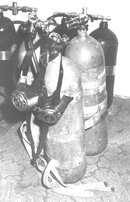DaleC
Contributor
I'm writing on my website about pony bottles and began wondering just when they made their appearance on the recreational diving scene? I seem to recall seeing early divers use extra bottles for deeper or possible deco dives but these were usually tied off on anchor or buoy lines for latter use. I also have seen images and read about 1960's (?) North Atlantic wreck divers using pony bottles mounted between their doubles (I assume they were non isolating manifolds). Does anyone remember a certain turning point or era when they began making an appearance in a non commercial setting?






